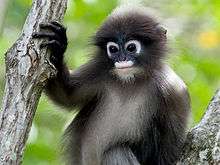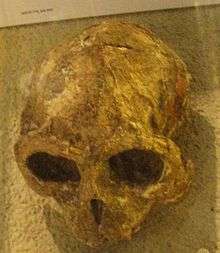Lutung
| Lutungs | |
|---|---|
 | |
| Dusky leaf monkey (Trachypithecus obscurus) | |
| Scientific classification | |
| Kingdom: | Animalia |
| Phylum: | Chordata |
| Clade: | Synapsida |
| Class: | Mammalia |
| Order: | Primates |
| Suborder: | Haplorhini |
| Infraorder: | Simiiformes |
| Family: | Cercopithecidae |
| Subfamily: | Colobinae |
| Genus: | Trachypithecus Reichenbach, 1862 |
| Type species | |
| Semnopithecus pyrrhus Horsfield, 1823 (= Cercopithecus auratus É. Geoffroy, 1812) | |
| Species | |
|
16, see text | |
The lutungs are a group of Old World monkeys and make up the entirety of the genus Trachypithecus. Their range is split into two parts; one part is much of Southeast Asia (northeast India, southern China, Borneo, Thailand, Java, and Bali), the other part is extreme southern India and Sri Lanka. The greater part of India has lutungs. Most of the species in this genus can be referred to as lutungs, langurs, or leaf monkeys.
The name "lutung" comes from the Sundanese language and means "blackness"; it is preferred by some authors because it distinguishes the genus from the "true" langurs of the Indian subcontinent.[1]
Description
Lutungs have a rather slim build with a long tail. The fur color varies, depending on the species, from black and grey to orange yellow. Many species have skin designs and a brighter lower surface, the hair on the head is often compared to a hood. Their arms are very short in comparison to the feet and their thumbs are also somewhat shorter. The inner surfaces of the hands and feet are hairless so that their fur does not get caught when reaching into branches. These animals reach a length of 40 to 80 cm and a weight of 5 to 15 kg, with males generally larger than females. A bulge over the eyes and other details, primarily in the head, differentiate it from the surilis.

Habitat and behaviour
Lutungs live in the forests, often preferring rain forests, although occasionally they are also found in secluded mountain forests. They spend the largest part of the day in the trees, where they crawl along the branches on all fours, although they can also jump well from tree to tree. They are diurnal, although more active in the early mornings and the afternoon.
They live in groups of ftve to 20 animals, mostly in harems, i.e. a single male with several females. Young males must leave their birth group when fully mature, often forming bachelor groups. If a new male takes over a harem, defeating and scaring off the harem leader, he often kills the children of the group. Lutungs are territorial, with loud shouting to defend their territories from other lutung interlopers, resorting to force if the outsiders are not scared off. They have a common repertoire of sounds with which they warn group members. Also, mutual grooming plays an important role.
Lutungs are herbivores, primarily eating leaves, fruits, and buds. To digest the tough leaves, they developed a multichambered stomach.
Reproduction
Rarely twins, a typical single birth comes after a seven-month gestation period. Newborns usually have a golden-yellow fur. The mother shares responsibilities of rearing the young with the other females ("aunties") of the harem. They hand the young around, play with it, carry it, and cuddle it, while the mother searches for food. If the mother dies, another female adopts the young animal. Lutungs are weaned in the latter half of their first year, and reach full maturity at 4 to 5 years. The life expectancy is estimated at 20 years.
Species
.jpg)
- Genus Trachypithecus
- T. vetulus group
- Purple-faced langur, Trachypithecus vetulus - moved into genus Semnopithecus
- Nilgiri langur, Trachypithecus johnii
- T. cristatus group
- Javan lutung, Trachypithecus auratus
- Silvery lutung or silvered leaf monkey, Trachypithecus cristatus
- Indochinese lutung, Trachypithecus germaini
- Tenasserim lutung, Trachypithecus barbei
- T. obscurus group
- Dusky leaf monkey, Trachypithecus obscurus
- Phayre's leaf monkey, Trachypithecus phayrei
- T. pileatus group
- Capped langur, Trachypithecus pileatus
- Shortridge's langur, Trachypithecus shortridgei
- Gee's golden langur, Trachypithecus geei
- T. francoisi group
- Francois' langur, Trachypithecus francoisi
- Hatinh langur, Trachypithecus hatinhensis
- White-headed langur, Trachypithecus poliocephalus
- Laotian langur, Trachypithecus laotum
- Delacour's langur, Trachypithecus delacouri
- Indochinese black langur, Trachypithecus ebenus
- T. vetulus group
Evolution

Genetic analysis indicates that the ancestors of the modern species of lutung first differentiated from one another a little over 3 million years ago, during the late Pliocene. The various species alive today then diverged during the Pleistocene, presumably driven by habitat changes during the Ice Ages.[2] The oldest fossils clearly identified as belonging to the genus date from the middle Pleistocene of Vietnam and Laos; later fossils are also known from Thailand, Java, and Sumatra. The closest living relatives of the lutungs are probably either the gray langurs or the surilis, although the exact relationships remain unclear, possibly due to hybridisation between these genera during the course of their recent evolutionary history.[1]
Trivia
The city Luodong in Taiwan is named after this monkey species.
References
- 1 2 Harding, L.E. (2010). "Trachypithecus cristatus (Primates: Cercopithecidae)". Mammalian Species. 42 (1): 149–165. doi:10.1644/862.1.
- ↑ Roos, C.; et al. (2008). "Mitochondrial phylogeny, taxonomy and biogeography of the silvered langur species group (Trachypithecus cristatus)". Molecular Phylogenetics and Evolution. 47 (2): 629–636. PMID 18406631. doi:10.1016/j.ympev.2008.03.006.
- Groves, C.P. (2005). Wilson, D.E.; Reeder, D.M., eds. Mammal Species of the World: A Taxonomic and Geographic Reference (3rd ed.). Baltimore: Johns Hopkins University Press. pp. 175–178. ISBN 0-801-88221-4. OCLC 62265494.
External links
| Wikispecies has information related to: Lutung |